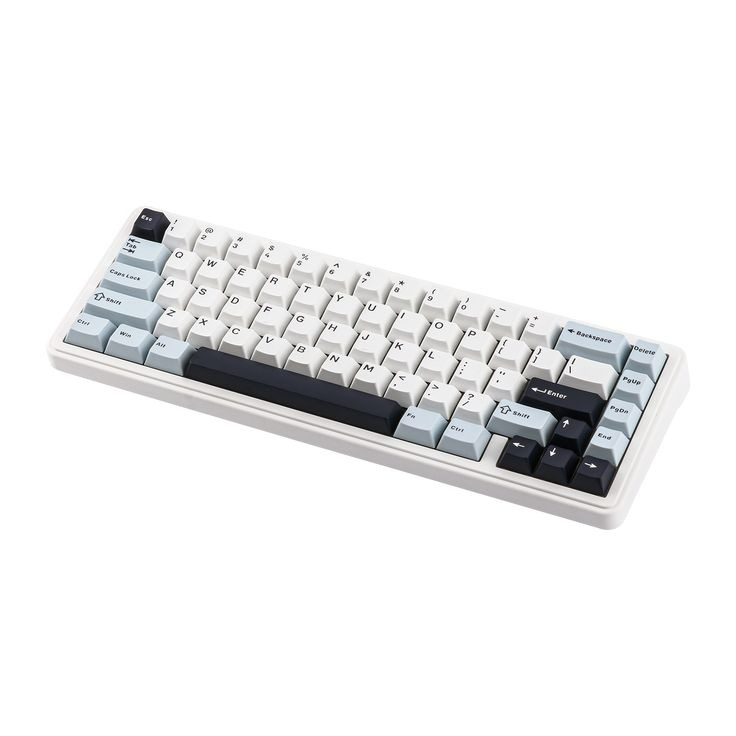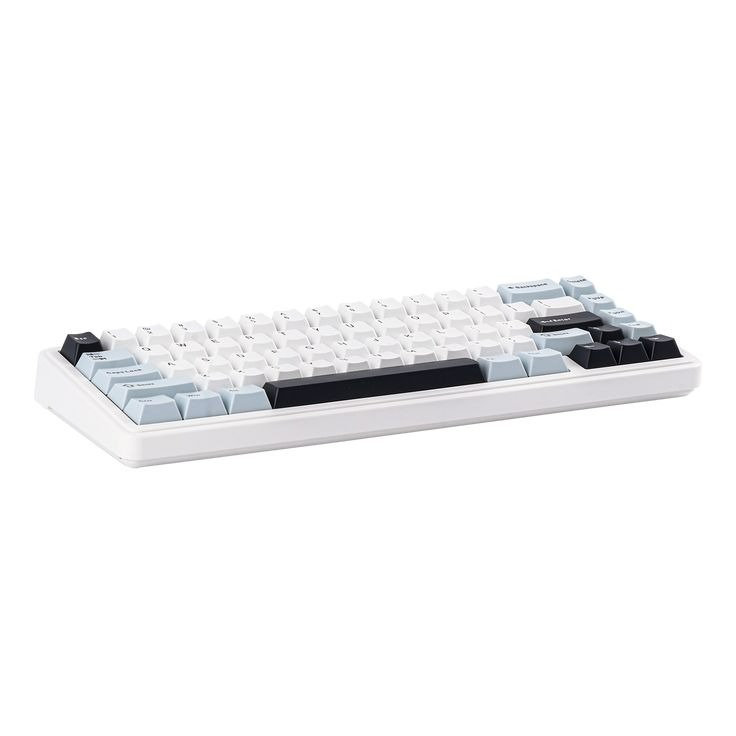Introduction to 65% Keyboards
A 65% keyboard is a compact option for users valuing desk space and portability. It includes the alpha-numeric cluster found on a traditional keyboard and adds arrow keys and a few navigation/function keys typically absent in smaller 60% variants. These keyboards skip the numpad and often the top function row, streamlining the layout without sacrificing too much functionality.
65% keyboards balance utility and minimalism, making them popular among enthusiasts and professionals alike. Their growing popularity stems from today’s diverse workspaces, which often require adaptable and space-efficient equipment. This keyboard type is especially ideal for those who perform tasks that benefit from a clean, uncluttered setup but still need access to arrow and function keys.
The compact design also makes a 65% keyboard a traveler’s friend, fitting easily into most bags and backpacks. For gamers, writers, or coders who need their setup to be as mobile as they are, it’s hard to overlook the blend of form and function that these keyboards offer.

Benefits of Compact Keyboard Designs
Compact keyboard designs, like the 65% keyboard, offer several benefits. They cater to the needs of today’s varied and dynamic work environments. Let’s explore these advantages.
Space Efficiency
The 65% keyboard’s smaller footprint frees up desk space. This extra room allows for a more organized workspace. It makes room for other tools and accessories, crucial for multitasking professionals.
Portability
These keyboards are lightweight and easy to transport. They fit in most bags, making them ideal for those on the move. Whether you’re working from a cafe or attending a gaming event, a 65% keyboard goes where you go.
Aesthetic Appeal
A clean setup can improve focus and workflow. The minimalist design of a 65% keyboard contributes to a streamlined desk that looks good and functions well.
Functionality
Despite their size, 65% keyboards retain essential functions. Arrow keys and a few necessary navigation keys are present. This ensures productivity does not suffer, even in a compact form.
In conclusion, the benefits of a compact keyboard design are clear. It offers space-saving, portability, aesthetic appeal, and efficiency. When selecting a keyboard, keep these points in mind to find the ideal balance for your needs.
Key Considerations When Selecting a 65% Keyboard
Choosing the right 65% keyboard requires careful thought. Here are key factors to consider before making your purchase.
Purpose and Use Case
Think about how you’ll use the keyboard. Are you a gamer, a writer, or a coder? Different uses may need different features.
Switch Type
Decide on the switch type. It affects the feel and sound of typing. Options include mechanical, membrane, or hybrid.
Build Quality
Check the build’s durability. It should withstand heavy use and last long. Quality materials make a difference.
Aesthetics
Consider the keyboard’s design. It should match your workspace style. Look for colors and materials that appeal to you.
Ergonomics
Ergonomic design is vital. It should promote comfort during long hours of use. Check for adjustable feet or wrist rests.
Price
Price ranges vary. Set a budget but don’t compromise on essential features. Sometimes, it’s worth paying more for quality.
Brand Reputation
Research the brand’s reputation. Read reviews and feedback from other users. A good track record often indicates reliability.
Extra Features
Look for additional features like programmable keys or backlighting. These can enhance your typing experience.
Remember, your choice of a 65% keyboard should align with your needs. Balance functionality, durability, and personal style to pick the perfect keyboard.

Understanding Switch Types for 65% Keyboards
When it comes to 65% keyboards, switch types play a crucial role in the typing experience. The switch, essentially, is the mechanism under each keycap that registers your keystrokes. Each type offers a different sound, tactile feedback, and overall feel, which can significantly affect your comfort and satisfaction while typing.
Mechanical Switches
Mechanical switches are popular for their durability and distinct tactile feedback. They come in various forms, like linear, tactile, and clicky, each providing a unique typing feel. Linear switches offer a smooth keystroke, while tactile switches give a noticeable bump and clicky switches make an audible click sound when activated. Gamers and typists who prefer a responsive keyboard experience tend to opt for mechanical switches.
Membrane Switches
Membrane switches offer a softer touch and are generally quieter than mechanical ones. They have a layer of rubber or silicone that registers the key press, ideal for those who work in shared spaces or prefer less noise.
Hybrid Switches
Hybrid switches combine features of both mechanical and membrane switches. They aim to offer the tactile feedback of mechanical ones with the quieter press of membrane switches. Users who are looking for a middle ground between the two may find hybrid switches to be a good compromise.
When selecting a 65% keyboard, understanding the characteristics of these switch types will help you make an informed decision. Think about your daily tasks, environment, and personal preferences. Whether you’re gaming, coding, or writing, there’s a switch type that’s suitable for your 65% keyboard that will enhance your typing experience. Remember, the right switch can make all the difference in your keyboard’s performance and your overall comfort during use.
Build Quality and Material Choices
When choosing a 65% keyboard, build quality cannot be overstated. It’s about how the keyboard feels, how well it holds up over time, and the materials used in its construction. Here’s what to consider:
Durability
Look for keyboards made from sturdy materials like aluminum or high-quality plastics. These materials ensure your keyboard can endure constant use without showing much wear and tear.
Weight
The weight of the keyboard often reflects its build quality. Heavier keyboards may indicate more metal used in construction, contributing to stability and durability.
Finish and Texture
Examine the finish of the keyboard. A good finish can resist fingerprints and smudges, keeping its aesthetic appeal over time. The texture should also be comfortable for long typing sessions.
Keycap Material
Keycaps come in different materials, such as ABS or PBT plastic. PBT keycaps are more durable and resistant to shine than ABS, but they can also be more expensive.
Case Construction
The case of the keyboard protects the internal components. It should be robust enough to prevent flexing and dampen the sound of keystrokes.
Plate Material
The plate is where the switches are mounted. It can be made from materials like steel, brass, or aluminum. Each has its own impact on the typing feel and sound.
In summary, the build quality and material choices of a 65% keyboard deeply impact its longevity, comfort, and performance. Paying attention to these details will ensure that you invest in a keyboard that not only looks good on your desk but also withstands the rigors of daily use.

Layout and Keycap Compatibility
When considering a 65% keyboard, layout and keycap compatibility are important. Here are some factors to keep in mind:
Standard vs. Custom Layout
- Standard Layout: Most 65% keyboards follow a standard layout. This makes finding compatible keycaps easier. Look for this if customization isn’t a priority.
- Custom Layout: Some keyboards come with a unique layout. This might require custom keycaps, which can be harder to find and more expensive.
Keycap Profiles
- Keycap Profiles: Keycaps come in different shapes, known as profiles. Common profiles are SA, DSA, and Cherry. Choose one that suits your typing style and comfort.
Keycap Material
- ABS: ABS keycaps are common but may develop a shine over time. They are usually less expensive.
- PBT: PBT keycaps are more resistant to wear and often preferred for their durability.
Compatibility with Accessories
- Key Pullers: Consider getting a keyboard with a standard layout if you plan to switch keycaps often. A key puller can be useful to have.
When selecting your 65% keyboard, ensure the layout and keycaps align with your preferences and needs. Good compatibility means more flexibility in customizing your typing experience.
Connectivity Options: Wired vs Wireless
When choosing a 65% keyboard, connectivity is a significant factor to consider. You have two primary options: wired and wireless. Here’s what to weigh in on each:
Wired Keyboards
Wired 65% keyboards connect via USB cable. They offer stability and no lag in response. They draw power directly from the connected device. This means you don’t have to worry about battery life. And they’re generally more affordable.
Wireless Keyboards
Wireless keyboards offer freedom from cords. Many connect via Bluetooth or a USB receiver. They provide flexibility and a cleaner desk space. But remember, they rely on batteries or charging. Wireless options can be pricier and sometimes have slight lag.
Decide based on your needs for mobility, desk setup, and consistency of connection. Both wired and wireless 65% keyboards have their merits. Your choice should fit your work or gaming lifestyle.
Recommended Brands and Models
When looking for a 65% keyboard, brand and model do matter. Here are top recommendations:
Mechanical Keyboard Brands
- Ducky: Known for build quality and vibrant designs.
- Vortex: Offers a good range of PBT keycap keyboards.
- Leopold: Prized for top-notch build and minimalist aesthetic.
Wireless Keyboard Brands
- Keychron: They’re a hit for their wireless capabilities.
- Anne Pro: Great for its compact layout and Bluetooth connectivity.
Budget-friendly Options
- Royal Kludge: They balance cost and features well.
- Akko: Known for colorful designs and affordability.
High-end Models
- HHKB (Happy Hacking Keyboard): A coder’s favorite with Topre switches.
- Varmilo: Provides excellent customizability and quality materials.
Do your research based on your specific needs. Consider build quality, switch type, and whether you prefer wired or wireless connectivity. With many well-regarded brands and models, you can find the perfect 65% keyboard that meets your gaming, writing, or coding needs while fitting your personal style and budget.
Conclusion: Finding the Right 65% Keyboard for You
In closing, choosing a 65% keyboard is quite personal. It hinges on how you plan to use it. Gamers, coders, and writers all have different needs. We’ve looked at switch types, build quality, and more. These factors guide you to the best fit.
Start by considering your daily tasks. You might need something sturdy, or maybe a soft keystroke matters more. Next, look at the materials. Durable keyboards last longer and often feel better. Don’t forget layout and keycap types. These affect how easy it is to customize your keyboard.
Connectivity is another big choice. If you move around a lot, wireless may suit you best. Yet, if you want reliability without fuss, wired could be the way to go.
Finally, think about cost and brands. There are options for every budget. Trusted brands often mean better quality and service. Take your time. Weigh all these factors. Choose a 65% keyboard that meets your needs and suits your style. It’s an investment in your comfort and efficiency.